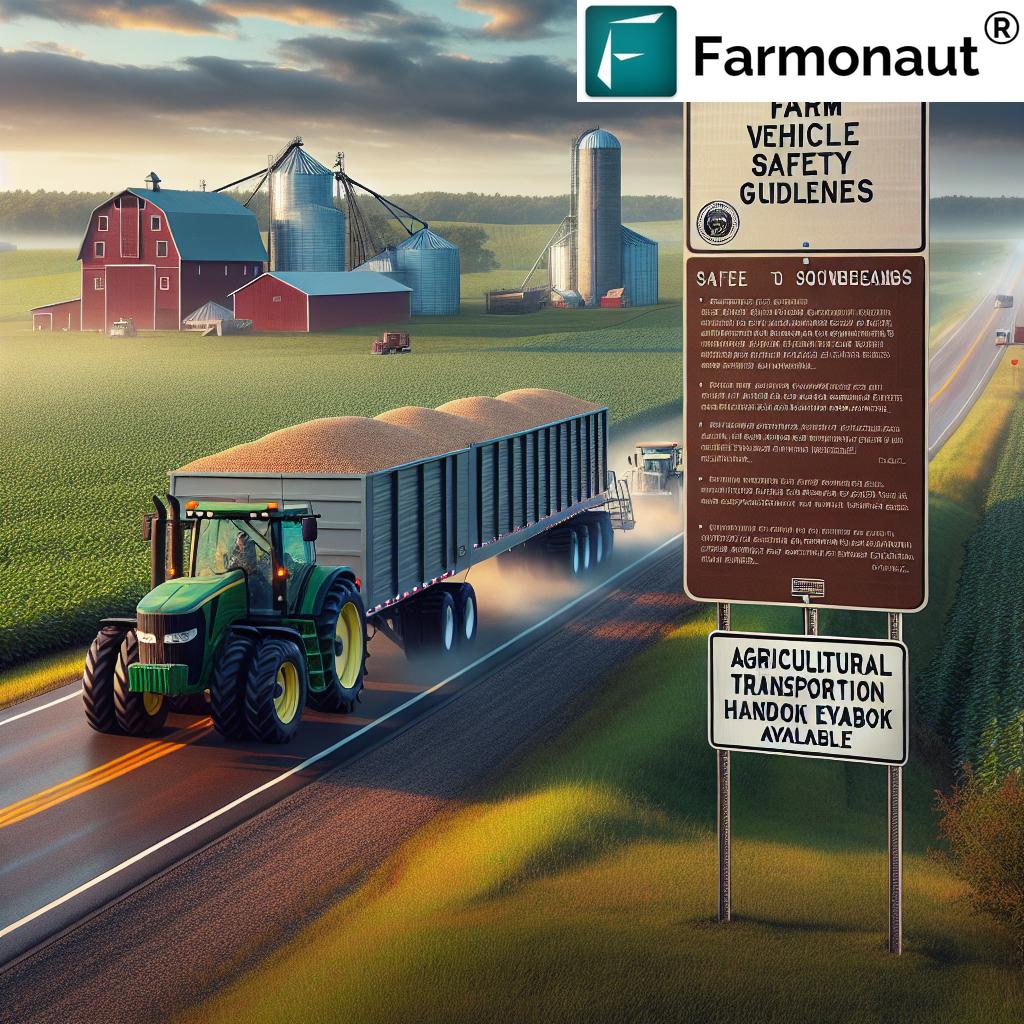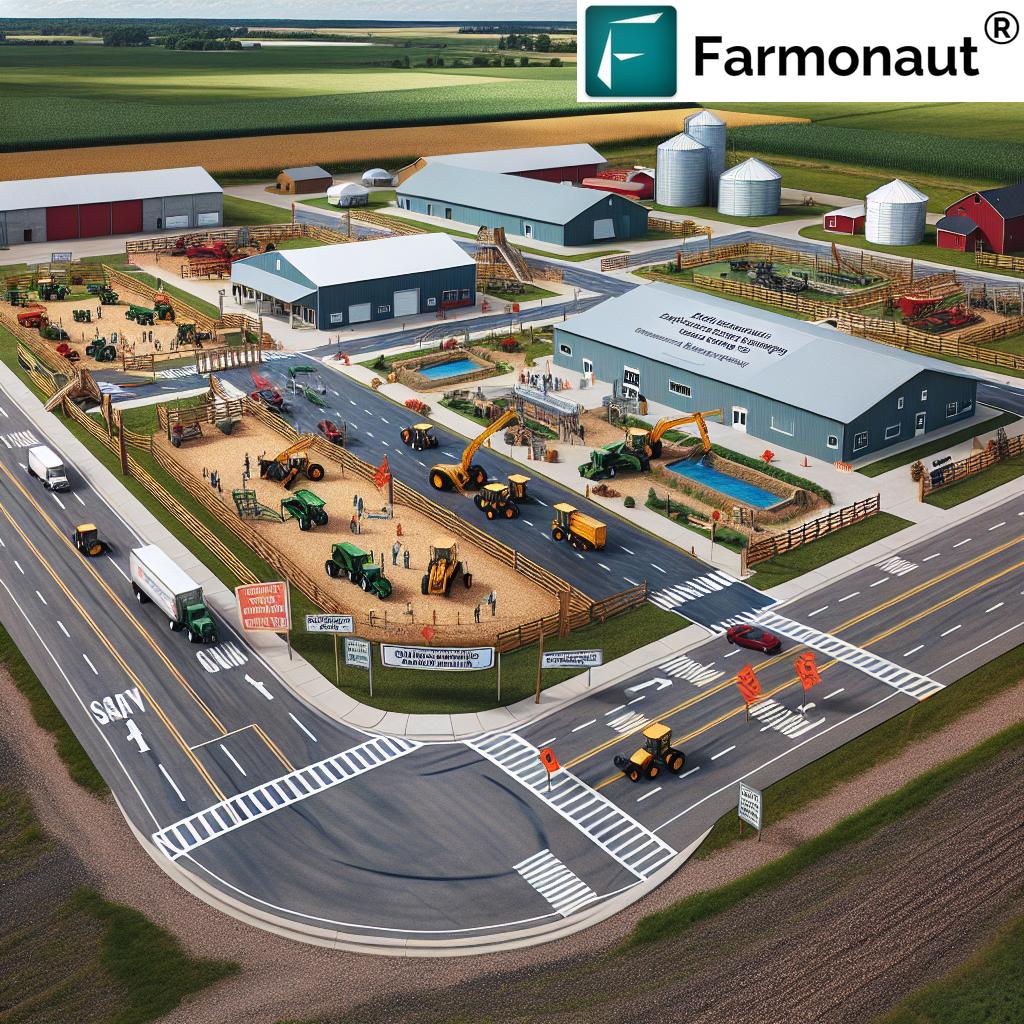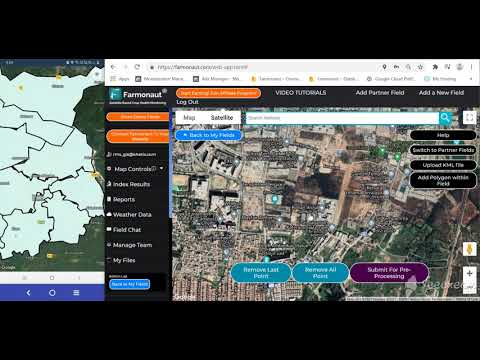Minnesota’s Essential Guide: Navigating Farm Transportation Laws for Sustainable Agriculture
“Minnesota’s agriculture transportation handbook covers over 10 essential topics, including farm vehicle exemptions and highway rules for farmers.”
Welcome to our comprehensive guide on Minnesota’s farm transportation laws and sustainable agriculture practices. As representatives of Farmonaut, we’re excited to share this vital information with our farming community. The recent revision of the Minnesota agriculture transportation handbook marks a significant milestone in our state’s commitment to safe and efficient agricultural operations.

In this blog post, we’ll delve into the crucial updates and guidelines that every farmer and rancher in Minnesota should know. From farm vehicle exemptions to biosecurity measures, we’ve got you covered. Let’s embark on this journey to understand how these new regulations can enhance our agricultural practices and contribute to a more sustainable future.
The Importance of Updated Transportation Laws in Agriculture
The revision of the Minnesota agriculture transportation handbook is more than just a routine update. It’s a testament to our state’s dedication to supporting farmers and ranchers in their essential work. By incorporating the latest state and federal statutes, rules, and exemptions, this handbook serves as a crucial tool for navigating the complex world of agricultural transportation.
Here’s why staying informed about these laws is crucial:
- Ensures compliance with current regulations
- Promotes safety on our highways
- Supports efficient transport of agricultural products
- Helps in maintaining biosecurity standards
- Contributes to sustainable farming practices
As we explore the various aspects of this handbook, remember that knowledge is power. By understanding and implementing these guidelines, we’re not just following rules – we’re actively contributing to the growth and sustainability of Minnesota’s agricultural sector.
Key Updates in Farm Vehicle Exemptions
One of the most significant areas of focus in the revised handbook is farm vehicle exemptions. These exemptions are crucial for farmers who need to transport their equipment and products on public roads. Let’s break down some of the key updates:
- Weight Limits: The handbook provides updated information on weight limits for various types of farm vehicles. This is essential for farmers to ensure they’re not overloading their trucks and risking fines or accidents.
- Distance Restrictions: There are new guidelines on how far farm vehicles can travel on public roads under certain exemptions. This is particularly important for farmers who need to transport goods to local markets or processing facilities.
- Seasonal Considerations: The handbook now includes more detailed information on seasonal exemptions, recognizing the unique needs of farmers during planting and harvest seasons.
Understanding these exemptions is crucial for our farming community. It allows for more efficient operations while ensuring we’re all staying within the bounds of the law.
Highway Rules for Farmers: What You Need to Know
The updated handbook provides comprehensive information on highway rules specifically tailored for farmers. These rules are designed to ensure the safety of both agricultural workers and other road users. Here are some key points to remember:
- Visibility Requirements: The handbook outlines updated requirements for lighting and reflective markings on farm vehicles. This is crucial for early morning or late evening travel.
- Speed Limits: There are specific speed limits for different types of farm vehicles. Adhering to these limits is essential for safety and legal compliance.
- Right-of-Way Rules: The handbook clarifies situations where farm vehicles may have different right-of-way rules compared to regular traffic.
By following these highway rules, we not only ensure our own safety but also contribute to the overall safety of our rural roads. Remember, safety is a shared responsibility, and as farmers, we play a crucial role in maintaining it.
Agricultural Product Transport Guidelines
Transporting agricultural products requires special attention to ensure quality and safety. The revised handbook provides updated guidelines on this crucial aspect of farming. Here’s what you need to know:
- Temperature Control: New guidelines on maintaining proper temperatures during transport, especially for perishable goods.
- Containment Requirements: Updated rules on how different types of agricultural products should be contained during transport to prevent spillage or contamination.
- Documentation: The handbook outlines the necessary documentation required when transporting agricultural products, ensuring smooth passage through checkpoints.
These guidelines are essential for maintaining the quality and safety of our agricultural products from farm to market. By adhering to these standards, we’re not just complying with regulations – we’re ensuring that our hard work reaches consumers in the best possible condition.

Biosecurity Measures: Protecting Our Farms and Livestock
Biosecurity is a critical aspect of modern farming, and the revised handbook places significant emphasis on this area. Here are some key biosecurity measures outlined in the handbook:
- Vehicle Sanitation: Updated guidelines on cleaning and disinfecting vehicles used for transporting livestock or agricultural products.
- Quarantine Procedures: Information on quarantine requirements when moving livestock between different areas.
- Pest Control: Guidelines on preventing the spread of pests during transportation.
Implementing these biosecurity measures is crucial for protecting our farms from diseases and pests. It’s not just about compliance – it’s about safeguarding the health of our livestock and the quality of our crops.
“The revised Minnesota agriculture handbook incorporates statutes from 2 levels of government: state and federal.”
Rural Trespassing Prevention: Protecting Your Farm
The handbook also addresses the important issue of rural trespassing. As farmers, protecting our property is crucial. Here are some key points from the handbook:
- Signage Requirements: Updated guidelines on proper signage to deter trespassers.
- Legal Rights: Information on farmers’ rights when dealing with trespassers.
- Reporting Procedures: Steps to take when reporting trespassing incidents to local authorities.
By understanding and implementing these guidelines, we can better protect our farms and ensure the safety of our operations.
Agricultural Education Programs: Staying Informed and Compliant
The handbook highlights the importance of ongoing education in the agricultural sector. Here are some key educational programs mentioned:
- Safety Training: Information on available safety training programs for farm workers.
- Compliance Workshops: Details on workshops that help farmers stay up-to-date with the latest regulations.
- Youth Education: Programs aimed at educating the next generation of farmers on sustainable practices and safety measures.
Participating in these educational programs is crucial for staying informed about the latest developments in agricultural transportation and safety. It’s an investment in our farms’ future and the sustainability of our industry.
Grants for Promoting Farm Safety
The handbook also provides information on various grants available for promoting farm safety. These grants can be incredibly beneficial for farmers looking to upgrade their equipment or implement new safety measures. Here’s what you need to know:
- Types of Grants: Overview of different grants available, from equipment upgrades to safety training programs.
- Application Process: Guidelines on how to apply for these grants.
- Eligibility Criteria: Information on who qualifies for these grants and under what conditions.
Taking advantage of these grants can help us enhance the safety of our farming operations without bearing the full financial burden. It’s an opportunity to invest in our farms’ future and the well-being of our workers.
Comparing Old and New Regulations
To help you better understand the changes in the revised handbook, we’ve prepared a comparative table of key regulations:
| Transportation Aspect | Previous Regulation | Updated Regulation |
|---|---|---|
| Farm Vehicle Weight Limit | 80,000 lbs | 90,000 lbs (with restrictions) |
| Maximum Travel Distance | 100 miles | 150 miles |
| Biosecurity Checks | Optional | Mandatory for livestock transport |
| Lighting Requirements | Basic reflectors | LED lights and reflective tape |
This table illustrates some of the significant changes in the regulations. It’s clear that the new rules aim to provide more flexibility while also enhancing safety measures.
The Role of Technology in Farm Transportation
As we navigate these new regulations, it’s important to recognize the role that technology plays in modern farming. At Farmonaut, we’re committed to providing innovative solutions that can help farmers comply with these regulations while improving efficiency. Here’s how technology can assist:
- GPS Tracking: Helps monitor vehicle routes and ensure compliance with distance restrictions.
- Satellite Monitoring: Provides real-time data on crop health, helping optimize transportation schedules.
- AI-Powered Advisory: Offers personalized recommendations for farm management, including transportation logistics.
By leveraging these technologies, we can not only ensure compliance with the new regulations but also enhance our overall farm management practices.
Sustainable Agriculture and Transportation
The revised handbook places a strong emphasis on sustainable agriculture practices, particularly in relation to transportation. Here’s how the new regulations support sustainability:
- Fuel Efficiency: Guidelines on selecting fuel-efficient vehicles for farm transportation.
- Reduced Emissions: Encouragement of practices that minimize carbon emissions during transport.
- Waste Reduction: Guidelines on proper handling of agricultural waste during transport to minimize environmental impact.
By adhering to these guidelines, we’re not just complying with regulations – we’re actively contributing to a more sustainable future for agriculture in Minnesota.
Accessing the Handbook and Additional Resources
The Minnesota Farm Bureau (MFB) Foundation has made it easy for farmers and ranchers to access this valuable resource. Here’s how you can get your copy:
- Contact Jenna Wegner at 651-768-2117 or email [email protected]
- Visit MFB booths at agricultural events like Farmfest and Big Iron
- Check the MFB website for digital versions and updates
Remember, staying informed is key to successful and compliant farm operations. Don’t hesitate to reach out and get your copy of this essential handbook.
Implementing the New Guidelines: A Step-by-Step Approach
Adapting to new regulations can be challenging, but with a systematic approach, we can ensure smooth implementation. Here’s a step-by-step guide to help you get started:
- Review the Handbook: Thoroughly read through the new handbook, paying special attention to areas that directly affect your operations.
- Assess Your Current Practices: Compare your current transportation practices with the new guidelines to identify areas that need changes.
- Develop an Implementation Plan: Create a timeline for implementing necessary changes, prioritizing safety-critical updates.
- Train Your Team: Ensure all farm workers are aware of the new regulations and trained on any new procedures.
- Update Equipment: Make any necessary upgrades to your vehicles or equipment to comply with new safety standards.
- Document Changes: Keep detailed records of the changes you’ve made to demonstrate compliance if needed.
- Regular Review: Set up a system for regularly reviewing and updating your practices as regulations evolve.
By following these steps, we can ensure that our farms are not only compliant with the new regulations but also operating at peak efficiency and safety.
The Impact of New Regulations on Farm Economics
While adapting to new regulations can initially seem daunting, it’s important to consider the long-term economic benefits. Here’s how the new guidelines can positively impact farm economics:
- Reduced Accident Risks: Improved safety measures can lead to fewer accidents, reducing potential liabilities and insurance costs.
- Increased Efficiency: Updated transportation rules can lead to more efficient routes and loading practices, saving time and fuel.
- Access to New Markets: Compliance with stringent safety and biosecurity measures can open doors to new, potentially more lucrative markets.
- Improved Product Quality: Better transportation practices can lead to improved product quality, potentially commanding higher prices.
By viewing these regulations as an investment rather than a burden, we can position our farms for long-term success and sustainability.
Collaborating for a Sustainable Future
The revision of the Minnesota agriculture transportation handbook is a testament to the power of collaboration in our industry. It’s the result of efforts from various stakeholders, including:
- Minnesota Farm Bureau (MFB) Foundation
- Minnesota Soybean Research and Promotion Council
- Commercial Vehicle Inspectors
- Minnesota State Patrol
- Federal Highway Department
This collaborative approach ensures that the guidelines are comprehensive and address the real needs of our farming community. As we move forward, let’s continue to foster this spirit of cooperation, sharing best practices and supporting each other in implementing these new regulations.
Looking Ahead: The Future of Farm Transportation in Minnesota
As we implement these new regulations, it’s exciting to consider what the future might hold for farm transportation in Minnesota. Here are some trends we might see:
- Increased Automation: Self-driving farm vehicles could revolutionize transportation logistics.
- Enhanced Traceability: Blockchain technology could provide unprecedented transparency in agricultural supply chains.
- Eco-Friendly Innovations: We may see a shift towards electric or hydrogen-powered farm vehicles to reduce environmental impact.
- Data-Driven Decisions: Advanced analytics could optimize transportation routes and schedules for maximum efficiency.
At Farmonaut, we’re committed to staying at the forefront of these technological advancements, providing farmers with the tools they need to thrive in an ever-evolving industry.
Conclusion: Embracing Change for a Stronger Agricultural Future
The revision of the Minnesota agriculture transportation handbook represents more than just updated regulations – it’s a roadmap for a safer, more efficient, and more sustainable agricultural future. By embracing these changes and leveraging technology, we can ensure that Minnesota’s farming community continues to thrive.
Remember, compliance with these regulations is not just about avoiding penalties – it’s about contributing to the overall health and sustainability of our industry. Let’s view this as an opportunity to improve our practices, enhance our efficiency, and reinforce Minnesota’s position as a leader in responsible and innovative agriculture.
As we navigate these changes together, don’t hesitate to reach out for support or to share your experiences. Whether you’re looking for technological solutions to aid compliance or simply need clarification on the new guidelines, remember that resources are available. Together, we can build a stronger, safer, and more sustainable agricultural future for Minnesota.
Earn With Farmonaut: Affiliate Program
Earn 20% recurring commission with Farmonaut’s affiliate program by sharing your promo code and helping farmers save 10%. Onboard 10 Elite farmers monthly to earn a minimum of $148,000 annually—start now and grow your income!
FAQ Section
Q: How often is the Minnesota agriculture transportation handbook updated?
A: The handbook is revised periodically to incorporate the latest state and federal regulations. It’s best to check with the Minnesota Farm Bureau for the most recent version.
Q: Are there any exemptions for small farms in these new regulations?
A: Yes, the handbook does include specific exemptions for small farms. However, these exemptions vary depending on the type of operation and transportation needs. It’s important to review the handbook for details specific to your situation.
Q: How can I stay updated on future changes to farm transportation laws?
A: The Minnesota Farm Bureau regularly provides updates through their website, newsletters, and local events. Additionally, participating in agricultural education programs can help you stay informed about upcoming changes.
Q: Are there any penalties for non-compliance with these new regulations?
A: Yes, there can be penalties for non-compliance, which may include fines or restrictions on farm operations. The severity of penalties often depends on the nature and extent of the violation.
Q: How can technology help me comply with these new regulations?
A: Technology can assist in various ways, from GPS tracking for route optimization to satellite monitoring for crop health. Farmonaut offers several solutions that can help farmers stay compliant while improving overall farm management.







